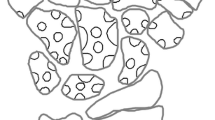Abstract
Purpose
Madelung deformity (MD) is a rare, normally painful abnormality of the wrist and forearm which characteristically begins in adolescence. Usually the deformity appears between the age of 8 and 14 years, often progressing from initially mild functional pain to fatigue and loss of strength and finally, reduced mobility. We present the MR-findings in three patients with bilateral MD, using a high-resolution imaging protocol adapted for 3.0 Tesla (3.0 T) examinations.
Materials and methods
Wrist images of three patients were acquired at a 3.0 T Scanner (Gyroscan Intera, Philips Medical Systems, Best, The Netherlands), using a dedicated phased array coil. The imaging protocol consisted of coronal T1-weighted Turbo-spin-echo (T1w-TSE) and coronal and sagittal T2-weighted TSE sequences (T2w-TSE).
Results
MR-images of these three girls demonstrated severe volar bayonet configuration of the forearms with a dorsal prominence of the ulnar head, also a curved distal radial articular surface with increased ulnar angulation, due to a deceleration of growth in the ulnar portion of the distal epiphysis. The proximal carpal row showed pyramidal configuration. Also visible was a prominent short radiolunate ligament, the so called Vickers ligament, which originates from the ulnar border of the radius, inserts into the volar pole of the lunate and likely contributes to carpal pyramidalization. Furthermore, the images demonstrated an anomalous hypertrophied and elongated volar radiotriquetral ligament which, to our knowledge, has been described elsewhere only in another case.
Conclusion
High resolution imaging at 3.0 T permitted a detailed analysis of the complex pathomorphology in patients with MD. Investing the better signal-to-noise ratio at higher field strengths into spatial resolution an excellent image quality could be obtained, depicting the Vickers ligament and the anomalous volar radiotriquetral ligament in this rare disease.








Similar content being viewed by others
References
Anderson BL, Lomasney LM, Demos TC, Bielski RJ (1997) Radiologic case study. Madelung’s deformity of the wrist. Orthopedics 20(576):569–571
Arora AS, Chung KC (2006) Otto W. Madelung and the recognition of Madelung’s deformity. J Hand Surg [Am] 31:177–182
Barr C, Bauer JS, Malfair D, Ma B, Henning TD, Steinbach L, Link TM (2007) MR imaging of the ankle at 3 Tesla and 1.5 Tesla: protocol optimization and application to cartilage, ligament and tendon pathology in cadaver specimens. Eur Radiol 17:1518–1528
Brooks TJ (2001) Madelung deformity in a collegiate gymnast: a case report. J Athl Train 36:170–173
Carter PR, Ezaki M (2000) Madelung’s deformity. Surgical correction through the anterior approach. Hand Clin 16:713–721, x-xi
Cook PA, Yu JS, Wiand W, Lubbers L, Coleman CR, Cook AJ 2nd, Kean JR, Cook AJ (1996) Madelung deformity in skeletally immature patients: morphologic assessment using radiography, CT, and MRI. J Comput Assist Tomogr 20:505–511
Dannenberg M, Anton JI, Spiegel MB (1939) Madelung’s deformity. Consideration of its roentgenological diagnostic criteria. AJR 42:671–676
Felman AH, Kirkpatrick JA Jr (1969) Madelung’s deformity: observations in 17 patients. Radiology 93:1037–1042
Grigelioniene G, Schoumans J, Neumeyer L, Ivarsson A, Eklof O, Enkvist O, Tordai P, Fosdal I, Myhre AG, Westphal O, Nilsson NO, Elfving M, Ellis I, Anderlid BM, Fransson I, Tapia-Paez I, Nordenskjold M, Hagenas L, Dumanski JP (2001) Analysis of short stature homeobox-containing gene (SHOX) and auxological phenotype in dyschondrosteosis and isolated Madelung deformity. Hum Genet 109:551–558
Lenk S, Ludescher B, Martirosan P, Schick F, Claussen CD, Schlemmer HP (2004) 3.0 T high-resolution MR imaging of carpal ligaments and TFCC. Rofo: Fortschritte auf dem Gebiete der Rontgenstrahlen und der Nuklearmedizin 176:664–667
Madelung (1879) Die spontane Subluxation der Hand nach vorne. Arch f klin Chir 23:395–412
Nielsen JB (1977) Madelung’s deformity. A follow-up study of 26 cases and a review of the literature. Acta Orthop Scand 48:379–384
Ross JL, Scott C Jr, Marttila P, Kowal K, Nass A, Papenhausen P, Abboudi J, Osterman L, Kushner H, Carter P, Ezaki M, Elder F, Wei F, Chen H, Zinn AR (2001) Phenotypes Associated with SHOX Deficiency. J Clin Endocrinol Metab 86:5674–5680
Saupe N, Prussmann KP, Luechinger R, Bosiger P, Marincek B, Weishaupt D (2005) MR imaging of the wrist: comparison between 1.5- and 3-T MR imaging–preliminary experience. Radiology 234:256–264
Stehling C, Bachmann R, Langer M, Nassenstein I, Heindel W, Vieth V (2009) High Resolution MR Imaging of TFCC lesions in acute wrist trauma: Image quality at different field strengths. J Comput Assist Tomogr (in press)
Stehling C, Vieth V, Bachmann R, Nassenstein I, Kugel H, Kooijman H, Heindel W, Fischbach R (2007) High-resolution magnetic resonance imaging of the temporomandibular Joint: Image quality at 1.5 and 3.0 Tesla in volunteers. Invest Radiol 42:428–434
Vickers D, Nielsen G (1992) Madelung deformity: surgical prophylaxis (physiolysis) during the late growth period by resection of the dyschondrosteosis lesion. J Hand Surg [Br] 17:401–407
Author information
Authors and Affiliations
Corresponding author
Rights and permissions
About this article
Cite this article
Stehling, C., Langer, M., Nassenstein, I. et al. High resolution 3.0 Tesla MR imaging findings in patients with bilateral Madelung’s deformity. Surg Radiol Anat 31, 551–557 (2009). https://doi.org/10.1007/s00276-009-0476-0
Received:
Accepted:
Published:
Issue Date:
DOI: https://doi.org/10.1007/s00276-009-0476-0




